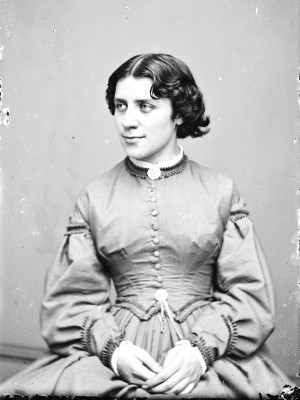Note: 2014 continues the 150th anniversary of the greatest conflict in which Americans were ever engaged – the Civil War. This is the thirty-eight in a series of articles providing a month by month synopsis from the pages of The Indianapolis Daily Journal of Hoosier reactions to national events.
Hoosiers entered the second month of the year with the announcement that another draft would occur in March, and with reports of a number of smallpox cases around the state — “in olden time pestilence followed war” — men, women, and children were urged to be vaccinated. Dr. William B. Fletcher attended a dozen cases of “spotted fever” in the Decatur Township community of West Newton. Edwin Adams, the young, dashing tragedian, began an engagement at Metropolitan Hall performing Hamlet, and later Richard III. He also appeared before “an immense assemblage” in a new tragedy, The Heretic. Over 400 reserved seats were sold at Masonic Hall for listeners to hear “the wonderful orator” young Anna Dickinson deliver her Words for the Hour, an elegant and eloquent, “searching and most rigid analysis of the causes of the war” that she had given last month in a lecture in the Hall of the U. S. House of Representatives that was attended by the President, members of Congress, and other dignitaries.
Twenty-five barracks were constructed on ground adjoining Camp Carrington making it “one of the largest camps in the West,” and the West Market House was fitted up to accommodate “about one thousand” returning re-enlisted veteran soldiers until they have been furloughed. Among several Indianapolis merchants receiving U. S. Commissary contracts were Pattison & Co for 30,000 pounds of bacon shoulders at 8.73¢(2012: $1.26) per pound, Harder & Root for 50,000 pounds of beans at 5.43¢ (2012: $0.79) per pound, Maguire, Jones & Co for 1,000 gallons of molasses at 68¢ (2012: $9.84) per gallon, and A. Stephens & Son for 800 pounds of black tea at $1.15 (2012: $16.65) per pound, and 20,000 pounds of roasted coffee at 43.95¢ (2012: $6.36) per pound. Amid concern expressed at the city council meeting that clothing stores in Indianapolis were making “extravagant profits from the sale of clothing to soldiers” at exorbitant prices, the Journal noted that “every well informed person knows that there are exceptions to the charge.”
“GO FIRE THE GUNS! Bring The Starry Banner Out. Shout For The Returning Heroes!” was the call as five more regiments — 22nd, 48th, 59th, 115th, and 117th — of veterans arrived in Indianapolis amid artillery salutes belching forth “welcome home” as the brave boys marched through the streets to the Soldiers’ Home to partake a dinner “of home-made table comforts” prepared by the ladies of the city. Following the meal, the regiments marched to the State House grounds where Gov. Morton’s “welcome…was as cordial as that of a father to his long absent sons.” State Librarian David Stevenson issued the first volume of Indiana’s Roll of Honor giving “a history of each regiment…its battles, marches, and adventures” which “an Indianan may read with interest and pride.” Recruits for old and new regiments mustered into service at Military Headquarters totaled 5,341 last month, and 581 recruits have taken the oath in the first ten days of the present month.
On the night of Thursday, February 11, a rebel prisoner at Camp Morton was shot and killed as he emerged from a hole in the ground outside of the fence. Two well-constructed tunnels, each twenty feet in length, were found leading to the east and north side of the camp from a barracks. The rebel prisoners in the barracks were questioned and admitted that they had planned to escape through the tunnels the following night. To prevent further tunneling, a deep trench has been dug between the barracks and the fence.
Two triumphal arches, one at Washington and Illinois Streets and the other at Washington and Pennsylvania Streets, decorated with “a mass of evergreens and flags” spanned Washington St. and framed a space that was a “very scarlet fever of flags” glistening from doors and windows, hanging from ropes across the street, and flying atop buildings in celebration of the anniversary of George Washington’s birthday. The city has never witnessed such an expression of patriotism solemnizing the memory of Washington. The following day the Union Party State Convention met and “heartily” endorsed the administration of President Lincoln and bound its National Convention delegates to support him for the Presidential nomination, “which very many were not willing to do, and which, being done, they bitterly resent.” The Journal noted that in nominating Gov. Morton to head the state ticket, “The State honors herself in placing her confidence in a man who has earned it so richly.” The exhibit at Masonic Hall of Johnson & Beale’s The Revolution of 1776, a colossal canvas covering over 40,000 square feet, provided the residents of Indianapolis with “an opportunity of seeing the great struggle portrayed in glowing colors and with magnificent effect.”
A new lodge of “Old Masonry” was established in the city. The Adoniram Lodge of Perfection and the Seraiat Council of Princes of Jerusalem have a “suite of very handsome and commodious rooms” in Yohn’s Block at the northeast corner of Meridian and Washington Streets. “The novelty of steam navigation on White River” was the discussion at a meeting of the Indianapolis Chamber of Commerce after the mud scow Lizzie Winkle, under steam power, came up from Waverly making the 30 mile trip in six hours, and returning the following day. In response to “the great drain…on the industrial resources” of Indiana as a consequence of the war, Gov. Morton will soon send to the press a pamphlet designed to promote emigration to the state. Printed in English, German, and French, the 75,000 copies promoting the qualities of Indiana will be circulated in Germany, France, and the British Empire with the view of largely increasing the “current of emigration to the State.”



